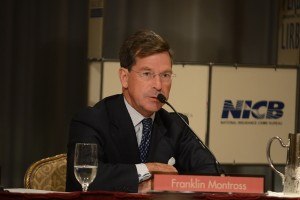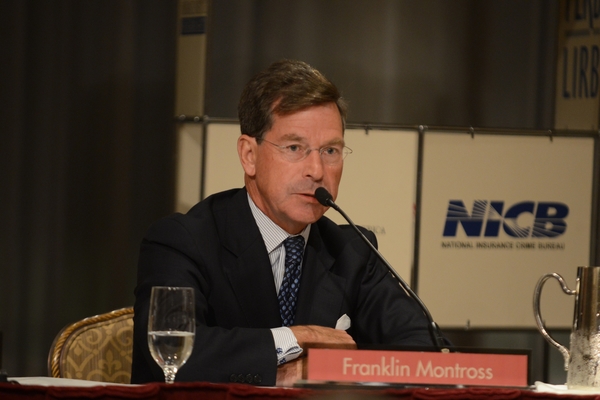“Twisted financial theories” and rating agency support are keeping the reinsurance space attractive to third-party investors, a reinsurance executive asserted at an industry conference this week.

While it was hardly surprising to hear Tad Montross, the chair, president and CEO of Gen Re, voice negative opinions about “alternative capital” in the reinsurance space, Montross supplemented his usual public comments with added swipes at A.M. Best and hedge fund investors, in particular, at a session of the PCI Annual Conference in Scottsdale, Ariz. earlier this week.
During a panel on reinsurance, Moderator Dan Hickey, an executive vice president at PartnerRe, asked Montross, known to be a skeptic about the staying power of third-party investors in the reinsurance segment, to talk about what might slow recent trends of increasing levels of alternative capital.
Choosing to discuss pension funds and hedge funds separately, Montross said there’s a mistaken perception that “hedge funds are the smartest guys in the room.”
On the contrary, “the average life a hedge fund is five years,” he said, suggesting that their short duration doesn’t marry well with the duration of reinsurance liabilities.
But for now, the appeal for the investors of setting up reinsurance companies and investing reinsurance proceeds in risky high-yielding assets is clear, he said. “If you could put $1 billion offshore and get a tax-free buildup, and write a little bit of reinsurance—low-[volatility] reinsurance—and then be able to repatriate at a capital gains rate rather than a regular income [tax rate] at some point in the future, it’s a pretty attractive business model.”
“And so, if A.M. Best keeps giving every hedge fund that wants to get into the reinsurance business an A-minus rating, that’s going to continue to happen,” Montross said.
As for pension funds investors, Montross said they’re searching for yield in a low-interest rate environment like everyone else. They are focused on insurance linked-securities or catastrophe bonds, and reinsurance has been sold to them as a noncorrelated asset class.
“That assumption is based on the past 15 years that the cat bonds have been in existence—even 20 now. [But] I would argue that the appropriate time to [analyze] correlations is after the $180 billion loss; and I think then the correlation is likely to go to one.
“So I think there is some financial theory that has been twisted,” he said.
Raising the question of what will happen when interest rates rise or there is a mega-catastrophe, Montross observed: “Out of the hundreds of bonds that have been issued, I believe only half of those have been triggered in a loss, and over half of those have been in dispute—either in litigation or arbitration over what the trigger was or how the bond was supposed to respond.
“So it’s really not clear to me after a large event just how resilient these are going to be.”
Separately, on an earnings conference call yesterday, Ed Noonan, the chair and CEO of Validus Holdings also referenced the litigation history associated with the ILS market, suggesting that the prevalence of litigation is starting to slow the appeal on the insurer or sponsor side of the market.
There is “too high a rate of litigation on covers that have been triggered in this market. Our sense is that we are at or near an equilibrium point for direct insurers’ use of this type of coverage,” Noonan said.
Noonan also gave other reasons to support the idea that buyers are reaching a saturation point in their use of ILS-backed coverage.
“Buyers are increasingly focused on the lack of reinstatement, the limited life of the product and the fact that there is no guarantee of renewability, all of which are meaningful limitations,” he said.
With the litigation theme, both Noonan and Montross echoed remarks made by John Charman and Denis Kessler, the chairs of Endurance Specialty Holdings and SCOR at the Standard & Poor’s Insurance conference in June.
At that meeting, Charman said, his biggest concern about third-party capital is that in the event of a major loss, the resulting litigation from third-party capital providers would be “reflected back” on the traditional reinsurance industry.
“Lawyers will be the big beneficiaries of the ILS movement,” Kessler added, contrasting a world of litigation on one side with the reinsurance world of cooperation and arbitration.
Charman said that the traditional reinsurance industry historically has responded extremely well to its cedents in the event of major losses. “It will be a test of the marketplace this time around when we actually do have another major loss as to how these different factions will respond,” he said.
Providing a different view during the PCI session this week, Bryon Ehrhart, CEO of Aon Benfield Americas, took issue with the idea that the pension funds will “cut and run” in the event of a large loss, suggesting that reinsurance executives just don’t understand how pension administrators operate.
“They have been through massive financial catastrophes”—much worse than the reinsurer CEOs are even contemplating. “If you look back at their histories, they are professionals. They have been at it, in most cases 30 or 40 years.
“The reason they have continued to make money is because they’ve stayed. They didn’t cut and run” when they experienced losses, he said, making a point he previously communicated to Carrier Management in an interview last year. At the time, Ehrhart used the example of a pension fund administrator whose multibillion 2009 mark-to-market loss of residential mortgages had evaporated years later because he stayed the course.
The Unicover Movie
Earlier in the session, Montross took issue with Ehrhart’s firm, and in particular, a report published by Aon Benfield in connection with midyear reinsurance renewals over the summer. According to Montross, the Aon Benfield report, which he didn’t specifically identify at the PCI conference but did source in a July blog item he authored for Gen Re’s website, said that reinsurance pricing for catastrophe coverage is at a “generational low.”
According to Montross, the report further argued that the cheaper reinsurance should be used by insurers to create cheaper gross-priced products or in someone’s capital.
Reacting to the idea, Montross said: “It’s fine to use cheap reinsurance … But I wouldn’t let that affect my gross pricing,” he said, going on to reference potential consequences like the Unicover debacle of the late 1990s.
Unicover was a pool of life insurers “that wrote workers comp reinsurance at 50 cents on the dollar. There was one set of clients that used it just to improve their financial performance, but didn’t affect their gross pricing. Another group reduced their gross pricing by as much as 40 percent.
“When that cheap reinsurance disappeared, four or five of those companies were insolvent within two years.”
It’s a “very very dangerous road to try to build what I would view as opportunistic reinsurance pricing right now as part of a long-term strategy,” Montross said.
In the July blog item, Montross concluded, “Any company that assumes this cheap alternative capital is permanent is taking a huge risk.”
In that same blog item, Montross gave his first public critique of hedge-fund reinsurers as well.
“The same brokerage firm [Aon Benfield] said ‘hedge fund-backed reinsurers seeking stable underwriting risks to complement sophisticated investment strategies will offer reinsurance terms attractive to classes that are not heavily reinsured today.’ The firm suggested that ‘auto and healthcare carriers are likely to lock in profits and become more capital-efficient.’
“We’ve also seen this movie before; it was called Risk Capital Re, which went out of business after just a few of years in business,” Montross wrote. “Writing reinsurance with the sole purpose of investing the float is backwards. Underwriting is the sustainable competitive advantage of any reinsurance or insurance enterprise that will be around to pay its claims for decades,” he wrote in the July blog item.





















 Good Times for U.S. P/C Insurers May Not Last; Auto Challenges Ahead
Good Times for U.S. P/C Insurers May Not Last; Auto Challenges Ahead  Berkshire Hathaway Enters Post-Buffett Era as Share Prices Fall
Berkshire Hathaway Enters Post-Buffett Era as Share Prices Fall  What to Expect in 2026: U.S. P/C Results More Like 2024
What to Expect in 2026: U.S. P/C Results More Like 2024  Why the Middle Market Matters and How Insurers Can Capture It
Why the Middle Market Matters and How Insurers Can Capture It 












